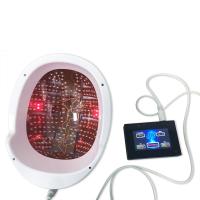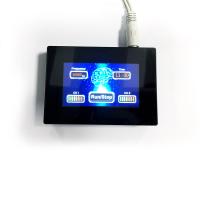No Pain Light Therapy Machine Brain Biomodulation Machine for
Multi-Diseases
HOPE FOR DEMENTIA SUFFERERSio
Due to global aging, the number of people with dementia is expected
to double every 20 years. People with dementia generally require
high levels of care, most of which is provided by informal
caregivers (i.e. family and friends). The Centers for Disease
Control reports that over 16 million Americans provide unpaid care
for people with Alzheimer’s or other dementias. These informal
caregivers, and the loved ones whom they help, are at an increased
risk of depression and a variety of other comorbid health
complications.
“Even after many years of research, a drug has yet to be developed
to benefit …neurodegenerative disorders (such as dementia,
Alzheimer’s, and Parkinson’s).” The few drugs that are prescribed
to help with dementia (cholinesterase inhibitors and memantine)
work temporarily and can have significant side effects. However,
there is growing evidence that supports the use of
photobiomodulation as a treatment for dementia.
EVIDENCE OF PHOTOBIOMODULATION AS TREATMENT FOR DEMENTIA
In 2017, Photomedicine and Laser Surgery published a clinical trial
on the effects of photobiomodulation therapy (PBMT). Five trial
participants received PBMT daily for 12-weeks with a 4-week
follow-up period. Each participant had been previously diagnosed
with dementia or AD. The study used the Medical Mental State Exam
(MMSE) and the Alzheimer’s Disease Assessment Scale (ADAS-cog) to
measure the severity of each participant’s dementia at baseline and
after 12 weeks of daily PBMT.
The study found that 12 weeks of daily PBMT significantly improved
cognition, sleep and anxiety, and reduced the frequency of
wandering as well as angry outbursts. In fact, one participant was
excused from the 4-week, no-treatment period because he experienced
a significant erosion of the positive effects of his 12-week PBMT.
His regression was considered an undue hardship for him and his
family, so the participant was permitted to continue daily PMBT.
There were no adverse events reported.
MORE INFORMATION
WHAT IS DEMENTIA?
Dementia is a descriptive term for cognitive impairment associated
with a loss of ability to perform daily functions, such as paying
bills, driving, and getting dressed. Common causes of dementia
include Alzheimer’s disease (AD), Parkinson’s disease, and
Huntington’s disease. Dementia can also be caused by other
conditions such as excessive alcohol use and cerebrovascular
strokes.
WHAT IS PHOTOBIOMODULATION?
Photobiomodulation therapy (PBMT) is a safe, non-invasive treatment
that has been featured in research since the 1960s. PBMT uses
visible, or near-infrared light (NIR) to stimulate, heal and repair
damaged or dying cells.
Although many PBMT studies on cognition have been small, their
results have been encouraging and warrant the future design of
placebo-controlled trials. As the evidence supporting PBMT as a
treatment option for dementia continues to grow, it is possible
that PBMT for dementia “will become one the of the most important
medical applications of light therapy in the coming years and
decades.”
HOW DOES LIGHT THERAPY WORK?
PBMT uses light to helps brain cells generate more cell energy,
called ATP. PBMT increases the cell’s absorption of photons, which
reduces inflammation and increases cerebral blood flow. As a
result, PBMT increases brain cells’ ability to self-repair and
communicate. Negative side effects have not been reported from the
use of PBMT.
It is well known that light helps skin cells produce vitamin D.
This is possible because visible light penetrates biological
tissues more than one might think. Interestingly, red and near
infrared (NIR) light penetrate deeper than green, blue, or violet
light. You can visualize this phenomenon by shining a white
flashlight through your hand, observing a red glow on the other
side (the blue and green wavelengths ‘disappeared’ because they
were absorbe
1. Introduction
Brain Photobiomodulation Machine The Brain Photobiomodulation
Machine is a therapeutic instrument based on the principle of
photobiomodulation. It has a good therapeutic effect on traumatic
events (stroke, traumatic brain injury, and global ischemia),
degenerative diseases (dementia, Alzheimer's and Parkinson's), and
psychiatric disorders (depression, anxiety, post traumatic stress
disorder).
2.Brain Photobiomodulation
Brain Photobiomodulation describes the use of red or near-infrared
light to stimulate, heal, regenerate, and protect tissue that has
either been injured, is degenerating, or else is at risk of dying.
One of the organ systems of the human body that is most necessary
to life, and whose optimum functioning is most worried about by
humankind in general, is the brain. The brain suffers from many
different disorders that can be classified into three broad
groupings: traumatic events (stroke, traumatic brain injury, and
global ischemia), degenerative diseases (dementia, Alzheimer's and
Parkinson's), and psychiatric disorders (depression, anxiety, post
traumatic stress disorder). There is some evidence that all these
seemingly diverse conditions can be beneficially affected by
applying light to the head. There is even the possibility that PBM
could be used for cognitive enhancement in normal healthy people.
In this transcranial PBM (tPBM) application, near-infrared (NIR)
light is often applied to the forehead because of the better
penetration (no hair, longer wavelength).
3.Specifications
| Name | Brain Photobiomodulation Machine |
| Model | GY-PDT1 |
| LED Wavelength | 810nm |
| Led Quantity | 256 |
| Power(total helmet) | 15W |
| Power(one LED) | 60mW |
| Power | 24mW/cm2 |
| Certificate | CE |
| OEM | Support |
| Color | White/Black |
| MOQ | 1PC |
4.Main Functions
• NIR light can penetrate the head and reach the brain.
• NIR is absorbed by cytochrome c oxidase in mitochondria.
• Heat-gated ion channels also play a role.
• Increased blood flow, energy, neuroprotection, less inflammation,
brain repair.
• Can treat traumatic (stroke, TBI), neurodegenerative and
psychiatric diseases.
5.Indications
1. Traumatic events (stroke, traumatic brain injury, and global
ischemia).
2. Degenerative diseases (dementia, Alzheimer's and Parkinson's).
3. Psychiatric disorders (depression, anxiety, post traumatic
stress disorder).
6.Contraindication
1. Avoid direct exposure to the eyes, pregnant women's abdomen,
melanoma, brown spots.
2. Taboo patients with early and middle stage malignant tumors.
3. Contraindications to patients with acute bleeding disorders.











